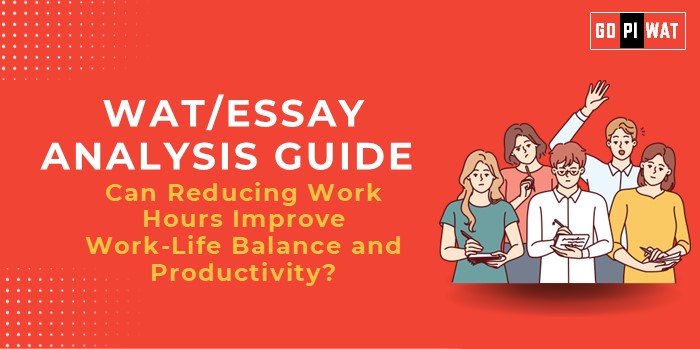⏳ Can Reducing Work Hours Improve Work-Life Balance and Productivity?
🌐 Understanding the Topic’s Importance
The debate over shorter work hours addresses key concerns in modern workplaces, such as employee well-being, productivity, and organizational efficiency. This topic resonates with broader themes of human resource management and workplace innovation, making it highly relevant for B-school discussions.
📋 Effective Planning and Writing
- Time Allocation: 5 minutes for brainstorming, 20 minutes for drafting, 5 minutes for review.
- Preparation Tips: Use recent case studies (e.g., Iceland, Japan) and balanced examples for nuanced arguments.
🎯 Introduction Techniques for Essays
Contrast Approach: “While shorter workweeks have revolutionized workplaces in Iceland, traditional sectors in developing countries may face hurdles in implementation.”
Solution-Based Approach: “Reducing work hours offers a promising route to better work-life balance, but can it be scaled universally?”
🏆 Structuring the Essay Body
✅ Achievements
- Mental Health Benefits: Reduced work hours in Iceland led to a 35% improvement in employee well-being.
- Productivity Gains: Microsoft Japan’s four-day workweek pilot resulted in a 40% increase in productivity.
- Environmental Impact: Shorter hours correlate with reduced carbon footprints due to decreased commuting.
⚠️ Challenges
- Feasibility Concerns: Industries requiring constant physical presence, such as healthcare or manufacturing, face operational challenges.
- Economic Impacts: Shortened hours may lead to reduced income for hourly workers in developing nations.
- Resistance to Change: Organizations with rigid hierarchies may be slow to adapt.
🚀 Future Outlook
Potential solutions include leveraging AI and hybrid work models to balance workloads and support operational efficiency. Policies promoting flexibility could help address industry-specific barriers.
📊 Concluding Effectively
Balanced Conclusion: “Shorter work hours hold immense promise for improving workplace well-being and productivity, yet require industry-specific solutions to ensure widespread feasibility.”
Global Comparison Conclusion: “Lessons from Iceland and Japan highlight the benefits, but global adaptation requires a nuanced approach.”
🔍 Analyzing Successes and Shortcomings
Key Achievements
- Enhanced productivity in knowledge-based sectors.
- Improved mental health for employees.
- Positive environmental impact.
Ongoing Challenges
- Operational adjustments for industries reliant on physical labor.
- Resistance from traditional organizations.
- Potential economic strain on hourly workers.
💡 Recommendations for Sustainable Progress
- 💼 Pilot Programs: Tailor pilot programs to different sectors to test feasibility and impact.
- 🤖 AI and Automation: Use technology to distribute workloads more efficiently.
- 📜 Policy Frameworks: Develop equitable policies ensuring the benefits of reduced hours reach all workers.
✍️ Sample Short Essays on the Topic
Balanced Perspective:
“Reducing work hours improves employee well-being and productivity in knowledge-based sectors. However, industries requiring physical labor need tailored solutions to ensure output remains unaffected.”
Solution-Oriented:
“Adopting shorter workweeks requires collaboration between governments and corporates. Flexible hours, supported by technology, can make this model successful across industries.”
Global Comparison:
“Iceland’s and Japan’s experiments with shorter work hours demonstrate promising results, offering a roadmap for other nations to address workplace stress and productivity challenges.”


